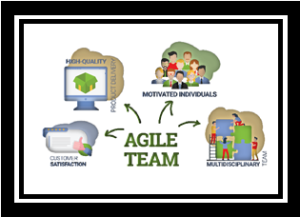Leveraging the Agile framework gives organisations a competitive advantage in today’s fast-paced and complex marketplaces. Embedding an Agile mindset of inspecting and adapting is the key element to the success of this service. Longer project timelines have proven somewhat inimical to organizational fortunes due to traditional project bureaucracies associated with its methods.
Contemporary times demand radical approaches to the business, and that is why the Agile framework promotes iterative deliverables which in many ways support quick roads-to-market and faster product adaptation from market feedback.
This feedback drives the in-depth study of organisations through business analysis by reviewing its business elements such as services, products, management styles, sustainable competitive advantages, marketing strategies and commercial viability can help formulate a set of findings on its future potential.  This systematic, thorough manner, using a range of analytical models, all the time ensuring both sensitivity and confidentiality is maintained; understanding a business perspective through quality requirements gathering solves half the problem.
This systematic, thorough manner, using a range of analytical models, all the time ensuring both sensitivity and confidentiality is maintained; understanding a business perspective through quality requirements gathering solves half the problem.
Business Automation replaces manual processes with intelligent rules-driven automation, just-in-time analytics, and open collaboration. Often, this is achieved with business automation software and similar tools. The technology allows organisations to streamline processes typically handled by employees.
For example, companies can use it to automate tasks associated with onboarding new hires. Other uses for business application processes include managing accounts payable transactions and approvals for business contracts.
Processes that fit the bill for transformation into an automation workflow include:
- Those that require consistency across a company
- Those that can be repeated
- Those that must be free of errors after each completion
 Companies can get a more accurate read on consumer behaviour with business automation software. That includes anticipating which products might become in demand. That way, businesses can ensure they have enough inventory on- hand to ensure customers have an optimal experience with their company. In addition, organizations can use the information collected via different workflows to refine customer interactions. The result can be higher sales, more efficient use of resources, and increased customer satisfaction.
Companies can get a more accurate read on consumer behaviour with business automation software. That includes anticipating which products might become in demand. That way, businesses can ensure they have enough inventory on- hand to ensure customers have an optimal experience with their company. In addition, organizations can use the information collected via different workflows to refine customer interactions. The result can be higher sales, more efficient use of resources, and increased customer satisfaction.
Business software helps you accomplish this by:
- Uncovering inefficient processes through data mining and data modelling
- Using intelligent recommendations to improve workflow functions
- Have workers collaborate with intelligence to improve productivity
- Automate core functions like document processing and content management
By automating manual business processes, organizations can realize significant benefits like:
- Greater Productivity
- Better Customer Service
- Increased Efficiency
- Improved Accuracy
- Full Audibility and Tracking
- Improved Job Satisfaction
 In general, intelligent automation can reduce transactional errors often committed by humans. In addition, companies can reduce the cycle time it takes to handle specific functions by a significant amount. That way, companies can better meet customers’ needs while improving business outcomes.
In general, intelligent automation can reduce transactional errors often committed by humans. In addition, companies can reduce the cycle time it takes to handle specific functions by a significant amount. That way, companies can better meet customers’ needs while improving business outcomes.

Recent Comments